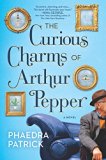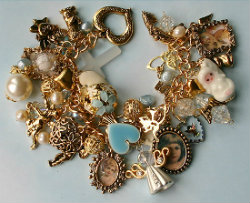Summary | Excerpt | Reviews | Beyond the Book | Read-Alikes | Genres & Themes | Author Bio

This article relates to The Curious Charms of Arthur Pepper
Today's charm bracelet can trace its origins back to Neolithic times when small rocks and other items considered to have special powers to ward off evil were carried around. Charms worn by Assyrians, Babylonians, Persians and Hittites were created from lapis lazuli, rock crystal and other gems and inscribed with symbolic designs, like figures of gods, humans and animals. They were closely associated with magical spiritual powers and served as protective talismans. Early Egyptians gathered such charms on necklaces and bracelets and the practice of using amulets to ward off evil continued through the Middle Ages.
 The move away from a charm's use as keeping evil spirits at bay can probably be attributed to the British monarch, Queen Victoria, who wore them as a fashion statement, even capturing a lock of her husband, Prince Albert's, hair in a charm. The popular royal's accessory came to be widely adopted by the public and slowly became a phenomenon, at least in the West. Tiffany introduced its first charm bracelet, a linked one with a little heart charm, in 1889 and it was a runaway hit.
The move away from a charm's use as keeping evil spirits at bay can probably be attributed to the British monarch, Queen Victoria, who wore them as a fashion statement, even capturing a lock of her husband, Prince Albert's, hair in a charm. The popular royal's accessory came to be widely adopted by the public and slowly became a phenomenon, at least in the West. Tiffany introduced its first charm bracelet, a linked one with a little heart charm, in 1889 and it was a runaway hit.
In the United States, the 1950s spawned a tradition of marking a young woman's coming of age with a charm bracelet with various charms added on to mark rites of passage. President Kennedy too had a charm bracelet with specific charms for his daughter Caroline and also ones that spoke of his Irish heritage. While the 1970s saw a lull in the popularity of charm bracelets, they have enjoyed a resurgence partly due to fashion's turn to all things vintage.
It should be noted that Italian charm bracelets are also in vogue but they don't have dangling charms and instead have patterns soldered onto a flat link which snaps onto an extensible bracelet.
Pictures of charm bracelet from sunnybeachjewelry.com
Filed under Cultural Curiosities
![]() This "beyond the book article" relates to The Curious Charms of Arthur Pepper. It originally ran in May 2016 and has been updated for the
January 2017 paperback edition.
Go to magazine.
This "beyond the book article" relates to The Curious Charms of Arthur Pepper. It originally ran in May 2016 and has been updated for the
January 2017 paperback edition.
Go to magazine.
If we did all the things we are capable of, we would literally astound ourselves
Click Here to find out who said this, as well as discovering other famous literary quotes!
Your guide toexceptional books
BookBrowse seeks out and recommends the best in contemporary fiction and nonfiction—books that not only engage and entertain but also deepen our understanding of ourselves and the world around us.